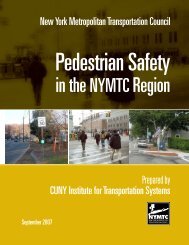Chapter 3 The Transportation System - New York Metropolitan ...
Chapter 3 The Transportation System - New York Metropolitan ...
Chapter 3 The Transportation System - New York Metropolitan ...
- No tags were found...
You also want an ePaper? Increase the reach of your titles
YUMPU automatically turns print PDFs into web optimized ePapers that Google loves.
<strong>Chapter</strong> 3ing peak delivery hours in the morningand allows passenger vehicles to parkoutside of the Delivery Window hours.Delivery Windows are typically installedalongside other NYCDOT efforts tomanage curb access and traffic congestionsuch as: bus rapid transit (i.e. SelectBus Service), curbside bike lanes, ParkSmart peak-rate parking programs, andcongested corridors programs. In 2010,a Delivery Windows program was implementedon a section of Church Avenuein Brooklyn to address congestionfrom double parking. Before the programwas implemented, double parkedtrucks blocked traffic for more than threehours a day and travel speeds were lessthan 10 miles per hour along much ofthe corridor. <strong>The</strong> corridor experienced a21 percent improvement in travel timewithin four months of the project beinginstalled. <strong>The</strong> Delivery Windows programhas also been implemented in locationsin Manhattan and the Bronx andis being explored for congested corridorscitywide.NYC deliverEASE, a program fundedby USDOT and initiated by NYCDOTand Rensselaer Polytechnic Institute(RPI), is an off-hour delivery programfocused on reducing congestion duringthe day. By shifting deliveries to the offhours,between 10:00pm and 6:00am,this program increases the competitivenessof the businesses located at the coreof the city while also easing traffic congestionduring the most congested hoursof the day. In 2010, NYCDOT served asthe lead coordinating agency for the US-DOT Research and Innovative TechnologyAdministration-funded Off-HourDelivery Pilot. <strong>The</strong> Manhattan Off-Hour Delivery Pilot research team wasled by RPI and included Rutgers University,the Rudin Center at <strong>New</strong> <strong>York</strong>University’s Wagner School, and ALKTechnologies. Participating businessesagreed to shift their deliveries to between7:00pm and 6:00am. Businesses foundthat fewer deliveries during normal businesshours allowed them to focus moreon their customers, and improved staffproductivity. Carriers found that theirtrucks could make more deliveries in thesame amount of time, they saved moneyon fuel costs, they used a smaller fleet bybalancing daytime and nighttime deliveries,and legal parking was more readilyavailable. <strong>The</strong>ir drivers reported feelingsafer and less stressed. <strong>The</strong> pilot alsodemonstrated the viability for permanentimplementation of off-hour deliveries onan expanded scale.TRUCK PARKINGTruck parking is an important aspectof goods movement. A NYMTC studyfound that peak demand for truck parkingoften exceeds 100 percent of availablecapacity, meaning there are notenough spots for trucks within the region.If nothing is done to reduce parkingdemand, NYMTC anticipates thatpeak demand will more than double by2030. When parking areas lack space,many trucks park along the shoulders ofhighways like I-84 or NY303 in RocklandCounty.<strong>The</strong> same study found that nearly 60percent of truck drivers interviewed hadstarted their trips in <strong>New</strong> <strong>York</strong> and <strong>New</strong>Jersey, while 50 percent of their destinationswere in either <strong>New</strong> <strong>York</strong> or <strong>New</strong>Jersey. <strong>The</strong> most cited starting points includeElizabeth and <strong>New</strong>ark, NJ; and theBronx, and Farmingdale, while the mostcited endpoints include Plattsburgh, theBronx, <strong>New</strong>burgh, and Brooklyn.<strong>The</strong> <strong>Transportation</strong> <strong>System</strong> 3-39
















